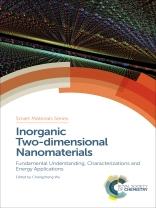Inorganic 2D nanomaterials, or inorganic graphene analogues, are gaining great attention due to their unique properties and potential energy applications. They contain ultrathin nanosheet morphology with one-dimensional confinement, but unlike pure carbon graphene, inorganic two-dimensional nanomaterials have a more abundant elemental composition and can form different crystallographic structures. These properties contribute to their unique chemical reaction activity, tunable physical properties and facilitate applications in the field of energy conversion and storage.
Inorganic Two-dimensional Nanomaterials details the development of the nanostructures from computational simulation and theoretical understanding to their synthesis and characterization. Individual chapters then cover different applications of the materials as electrocatalysts, flexible supercapicitors, flexible lithium ion batteries and thermoelectrical devices.
The book provides a comprehensive overview of the field for researchers working in the areas of materials chemistry, physics, energy and catalysis.
Innehållsförteckning
Exploring Two-Dimensional Crystals with Atomic Thickness from Molecular Design and Global Structure Search; Degree of buckling on mechanics of ultrathin sheets; Surface modification for engineering the intrinsic magnetic properties of inorganic 2D nanomaterials; Optical and optoelectronic properties of two-dimensional materials; Solid-state Synthesis of two-dimensional layered crystal; Liquid Phase Synthesis of Two-Dimensional Crystals: from Top-down to Bottom-up; growth mechanism of 2D nanomaterials; The investigations of two dimenstional materials by scannning tunneling microscopy; Characterizing the structures of atomically thin two-dimensional transition metal chalcogenide by advanced electron microscopy; Synchrotron Radiation Spectroscopic Techniques for Two-Dimensional Materials; Inorganic two-dimensional nanomaterials for electrocatalysis; Two-dimensional nanomaterials applying for the flexible supercapacitors; Inorganic two-dimensional nanostructures for flexible lithium-ion batteries; Two-dimensional nanomaterials ideal platform to understand photocatalysis; Two-dimensional nanomaterials: promising candidate for thermoelectric application












